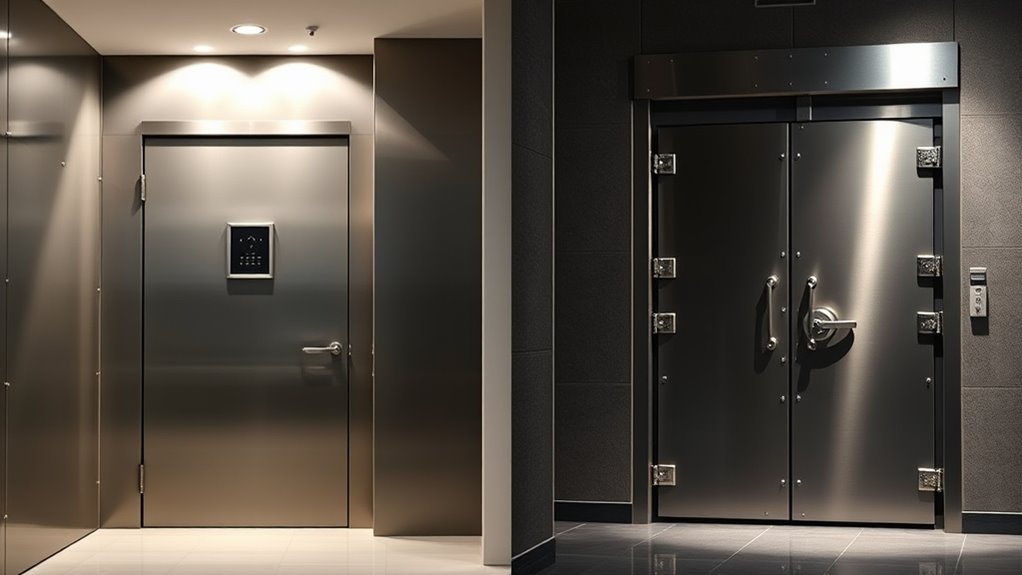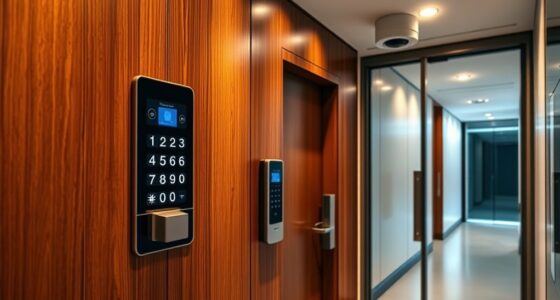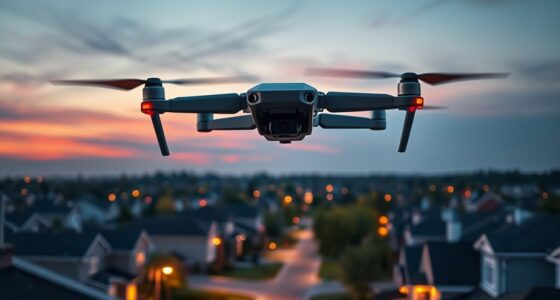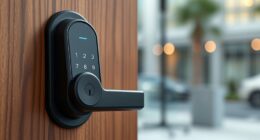A residential safe room is designed for long-term shelter during events like tornadoes or hurricanes, providing secure, comfortable space until danger passes. A panic room offers quick refuge during immediate threats like home invasions, focusing on rapid access and escape. Safe rooms prioritize durability and amenities, while panic rooms emphasize swift security measures. Understanding these differences helps you choose the right solution for your safety; learn more if you’re interested in details.
Key Takeaways
- Safe rooms are designed for long-term shelter during threats like natural disasters, while panic rooms provide quick refuge during home invasions.
- Safe rooms often include amenities for extended stays; panic rooms focus on rapid access and emergency egress.
- Both use reinforced construction; safe rooms emphasize security for prolonged protection, panic rooms prioritize swift entry.
- Safe rooms are centrally located for sustained protection; panic rooms are positioned for immediate access in emergencies.
- Proper maintenance, supplies, and planning are essential for both, but their features are tailored to different threat durations.
Purpose and Primary Function

Both residential safe rooms and panic rooms serve the critical purpose of protecting you during emergencies, but they differ in their primary functions. Safe rooms focus on providing a secure space where you can feel psychologically safe, reducing fear during threats like break-ins or natural disasters. They often include emergency communication tools, so you can contact help if needed. Panic rooms, on the other hand, are designed for immediate physical protection, offering a fortified space to hide until help arrives. While both provide safety, safe rooms emphasize mental reassurance and communication, helping you stay calm and connected. Understanding these differences helps you choose the right space to enhance your overall safety strategy. Additionally, the design and construction of these rooms can benefit from advanced security features, ensuring better protection and peace of mind.
Design and Construction Features
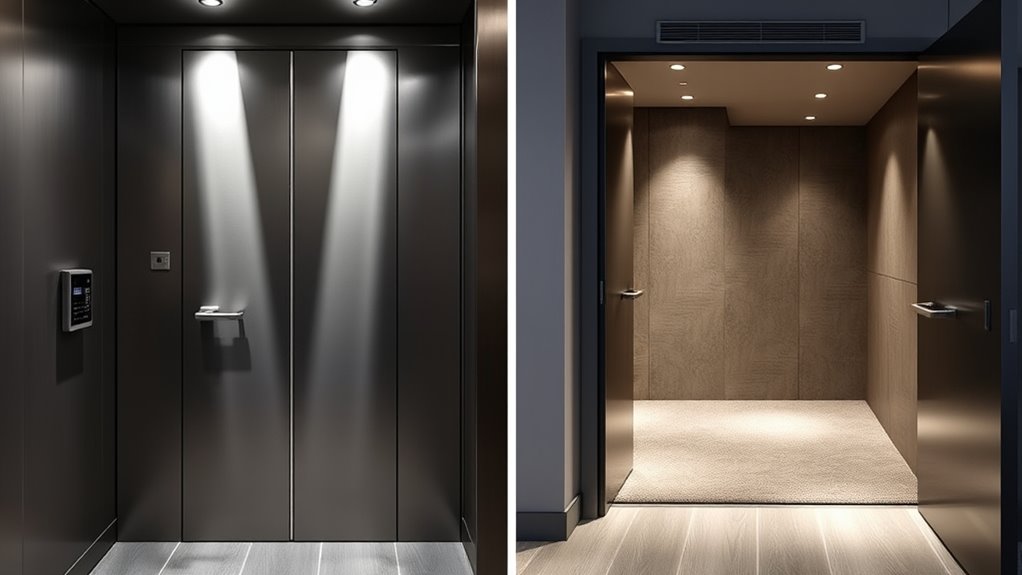
When choosing a safe or panic room, you’ll want to take into account the materials and reinforcement used in its construction to ensure durability. Access and egress features are equally important, as they determine how quickly and safely you can get in or out during an emergency. Paying attention to these design and construction elements helps you create a secure, functional space that meets your needs. Additionally, incorporating automation features can enhance safety by providing real-time alerts and assistance during emergencies.
Design Materials and Reinforcement
Choosing the right materials and reinforcement is essential for guaranteeing your safe or panic room can withstand threats effectively. To meet safety standards and maximize material durability, select high-quality construction elements. Key considerations include:
- Use reinforced concrete walls and ceilings for superior impact resistance.
- Opt for steel framing to enhance structural integrity.
- Incorporate ballistic-resistant materials if threat levels demand higher protection.
- Seal gaps with robust, fireproof sealants to prevent unauthorized access and contain hazards.
Prioritizing these features ensures your room remains resilient under attack or disaster scenarios. Remember, adherence to safety standards guarantees your safety measures are reliable. Investing in durable, high-grade materials not only provides peace of mind but also extends the lifespan of your safe or panic room, making it a sound, long-term choice.
Access and Egress Features
Ensuring quick and safe access to your safe or panic room relies on carefully designed entry and exit points. You need an emergency escape route that allows you to exit swiftly if the main access is compromised. This might include a reinforced secondary door or a hidden exit, providing peace of mind during emergencies. Ventilation options are also essential; proper airflow ensures you stay comfortable and alert inside, especially during prolonged stays. Consider installing ventilation systems that can be sealed or opened quickly, depending on the threat level. Egress features should prioritize ease of use without sacrificing security, enabling you to leave or enter rapidly while maintaining protection. Thoughtful access design enhances safety and functionality, giving you confidence in your room’s ability to serve its purpose effectively. Incorporating safety features aligned with current security standards can further improve the overall resilience of your emergency space.
Accessibility and Location
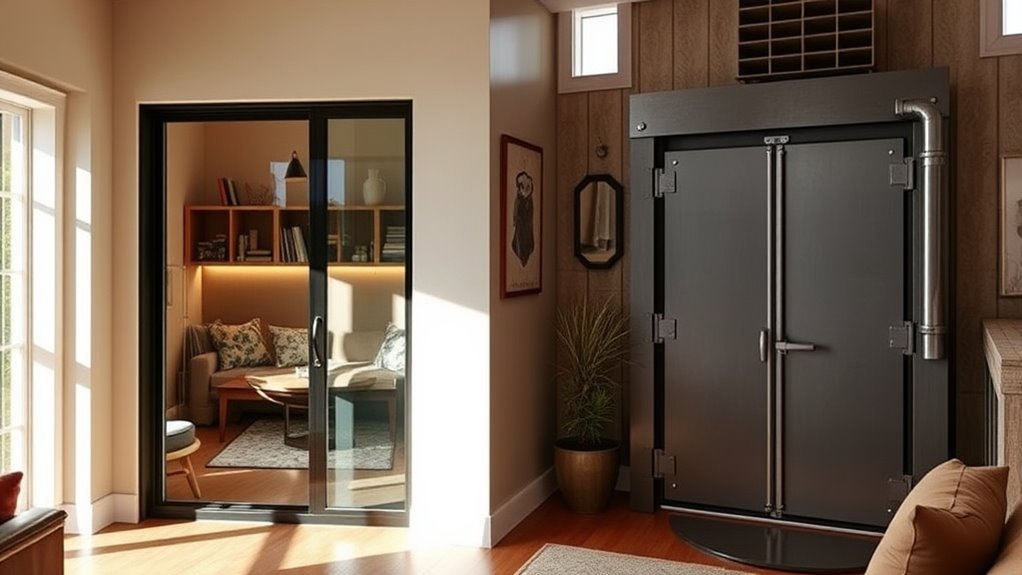
You want your safe or panic room to be easy to reach quickly, so consider its placement carefully. Think about locations that are central and accessible from different parts of your home. Strategic positioning guarantees you can get inside swiftly when seconds count. Additionally, choosing a location with easy access to emergency supplies can be crucial during a crisis.
Easy Access Points
Accessibility and location are critical factors when deciding between a residential safe room and a panic room. You want quick, easy access during emergencies, so consider these points:
- Ensure emergency exits are simple to reach and use under stress.
- Choose a location close to main living areas for fast access.
- Verify that door lock mechanisms allow rapid entry but prevent unauthorized access.
- Avoid placing the room in hard-to-reach or isolated spots that could delay your response.
- Incorporating quick-access features like keypad or biometric entry can significantly improve response times during emergencies.
Strategic Placement Considerations
Choosing the right location for your safe room or panic room can considerably impact how quickly you can respond during an emergency. You want it to be easily accessible from common areas without compromising safety. Consider neighborhood integration to ensure the room’s placement doesn’t stand out or cause unnecessary alarm. It’s also essential to balance aesthetic considerations so the safe room blends seamlessly with your home’s design, avoiding a bulky or obvious appearance. Strategic placement near bedrooms or main living spaces ensures quick access when needed. Keep in mind that a discreet location can help maintain your home’s overall aesthetic while providing security. Proper planning ensures your safe or panic room offers both safety and harmony within your household’s everyday environment.
Equipment and Supplies
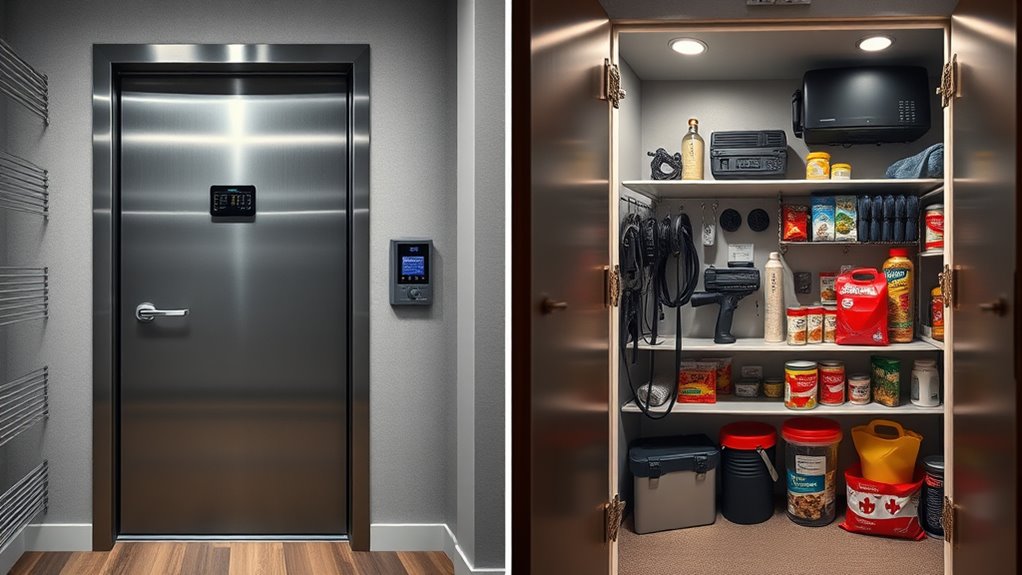
Proper equipment and supplies are essential for ensuring safety and preparedness inside your safe or panic room. Having the right tools can make a significant difference during emergencies. Focus on items that support communication devices, which are vital for disaster preparedness, enabling you to contact authorities or loved ones. Keep these supplies readily accessible: 1. A battery-powered radio or NOAA weather radio for updates 2. A fully charged cell phone with extra power banks 3. First aid kit for injuries 4. Emergency supplies such as bottled water, non-perishable food, and flashlights. Ensuring your supplies include candles can provide additional illumination and comfort during power outages. These essentials help you stay informed, connected, and self-sufficient during crises, ensuring your safety until help arrives or conditions improve. Properly equipping your room is a crucial step in thorough disaster preparedness.
Security Measures and Reinforcements
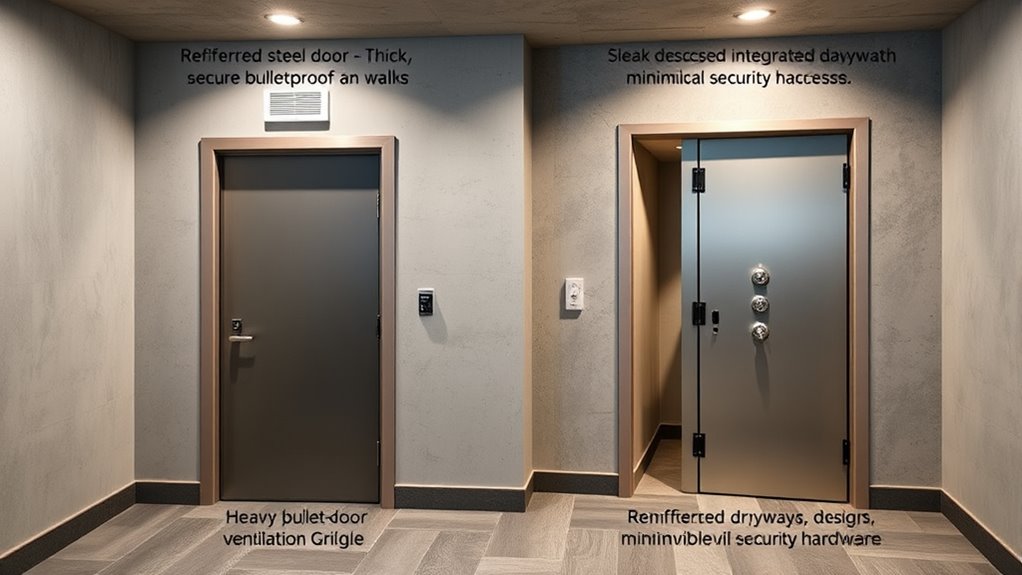
Implementing effective security measures and reinforcements is essential to preventing unauthorized access and ensuring your safe or panic room remains a secure refuge. Start by installing a reliable alarm system that alerts you immediately to any breaches. Reinforce doors and windows with sturdy materials like steel or reinforced glass to resist forced entry. Keep emergency contacts easily accessible, including local law enforcement and security services, so you can quickly call for help if needed. Consider adding surveillance cameras for real-time monitoring. Regularly test your alarm system and reinforce weaker points to maintain security integrity. Security awareness is vital to understanding potential vulnerabilities and ensuring your safety measures are comprehensive. These measures work together to deter intruders and provide peace of mind, knowing your safe or panic room is well-protected and ready when you need it most.
Typical Use Scenarios
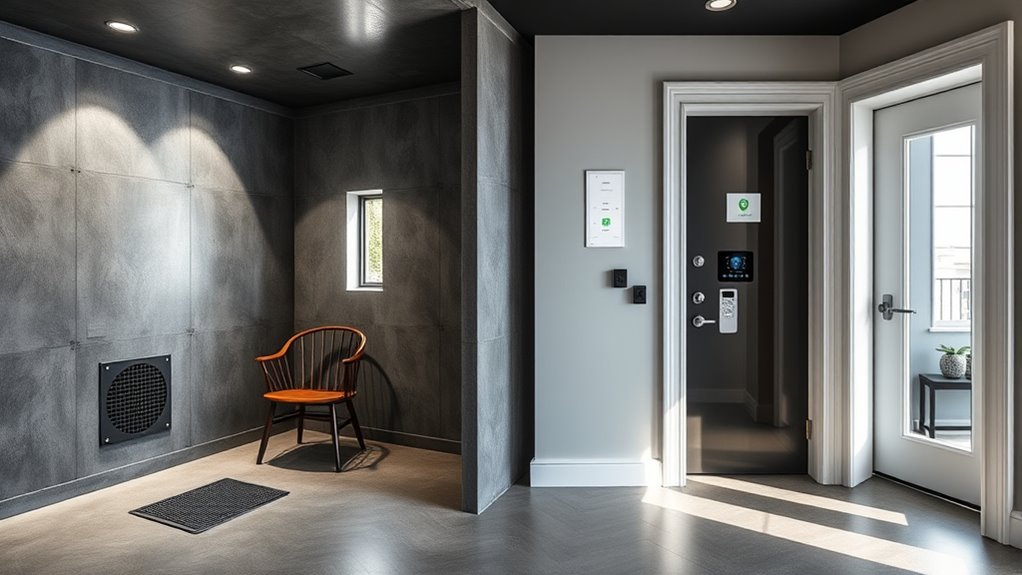
Residential safe rooms and panic rooms serve different purposes depending on the situation. You might use a panic room during a home invasion, while a safe room is ideal for evacuation drills or natural disasters. Safe rooms are designed for long-term protection, so you can stay there during emergencies like tornadoes or hurricanes. Panic rooms are more for immediate threats, providing quick refuge. Keep in mind that:
- Regular maintenance routines guarantee your safe or panic room remains secure.
- Evacuation drills help you become familiar with using your safe room efficiently.
- Panic rooms are suited for quick access during sudden threats.
- Safe rooms are better for sustained shelter during extended emergencies.
- Ensuring your security features are functioning properly is essential for both types of rooms.
Understanding these scenarios helps you choose the right space for each situation and maintain its effectiveness.
Frequently Asked Questions
What Is the Cost Difference Between Safe Rooms and Panic Rooms?
The cost comparison between safe rooms and panic rooms varies mainly due to size, materials, and features. Generally, panic rooms tend to be more expensive because they often include more security features and require professional installation, increasing installation expenses. Safe rooms are usually simpler and less costly. Expect to spend anywhere from a few thousand dollars for basic safe rooms to over $50,000 for high-end panic rooms with advanced security systems.
Can Existing Rooms Be Converted Into Safe or Panic Rooms?
Sure, you can convert existing rooms into safe or panic rooms, though don’t expect it to be as simple as turning a closet into a fortress overnight. You’ll need some serious room conversion and structural reinforcement to withstand threats. Think thicker walls, reinforced doors, and secure windows. It’s like giving your space a superhero upgrade—just remember, not every room is ready for the cape, so consult experts before you start.
How Long Can a Safe Room Sustain Occupants During an Emergency?
You can typically sustain occupants in a safe room for several days during an emergency, depending on its design and supplies. Properly stocked with water, food, and emergency essentials, your shelter duration can extend, ensuring emergency survival until help arrives or danger passes. Regularly maintaining and updating your supplies helps you stay prepared, giving you peace of mind knowing your safe room can support you through prolonged crises.
Are There Legal or Zoning Restrictions for Installing These Rooms?
You should check local laws and zoning regulations before installing a safe or panic room. Legal restrictions may include building codes, permits, or safety standards, while zoning rules could limit where you can place these rooms. You need to consult your city or county planning department to verify compliance. Following these guidelines helps avoid fines, delays, or legal issues, making your home safer and legally compliant.
What Maintenance Is Required to Keep Safety Features Effective?
To keep your safe or panic room effective, you should regularly perform security upgrades like updating locks and alarms. Check doors, windows, and ventilation systems for any damage or wear, guaranteeing they operate smoothly. Maintain emergency preparedness by testing communication devices and stockpiling supplies. Routine inspections and prompt repairs help safeguard your space, giving you peace of mind during emergencies. Staying proactive ensures your safety features remain reliable when you need them most.
Conclusion
So, whether you’re choosing a cozy safe room or a full-blown panic fortress, remember—both are just fancy closets with a touch of paranoia. One’s for everyday peace of mind, the other for when the world’s gone completely nuts. Either way, you’ll sleep better knowing you’ve invested in the ultimate “just in case.” Because nothing says ‘prepared’ like a high-security fortress hiding behind a perfectly ordinary door. Stay safe, or at least look prepared!
